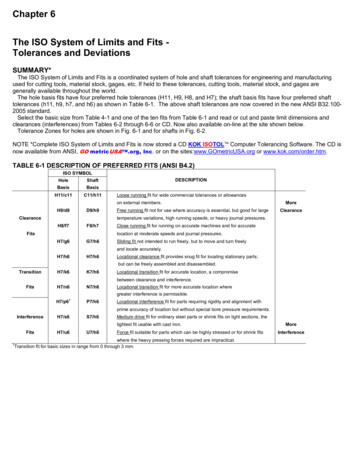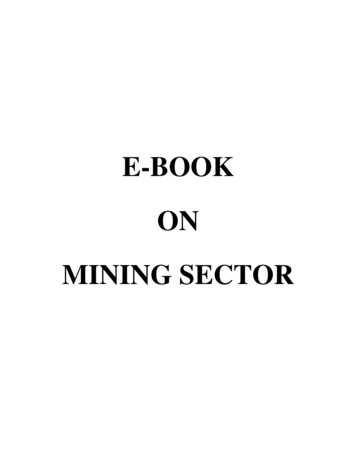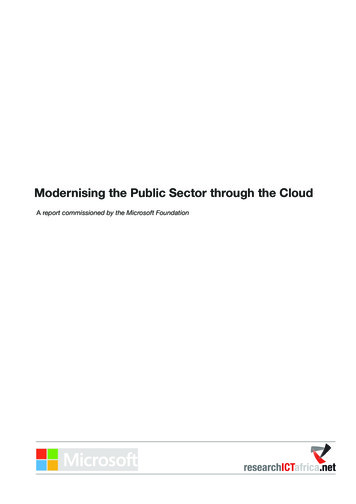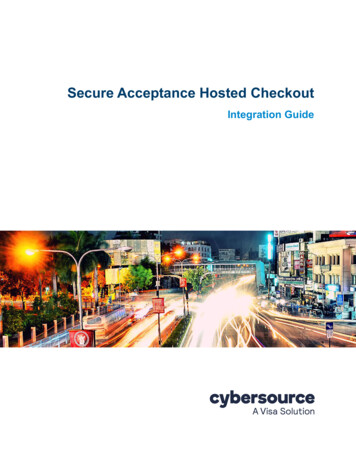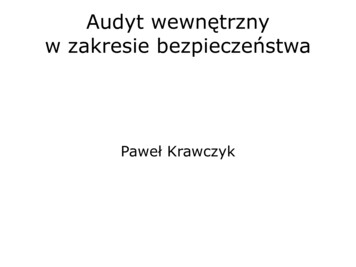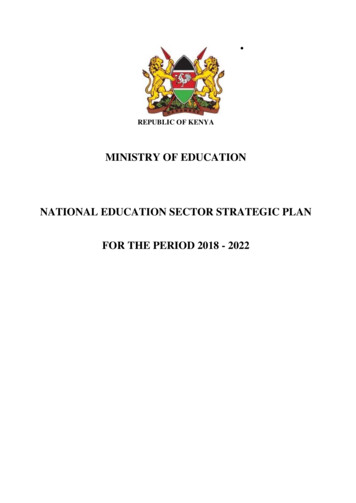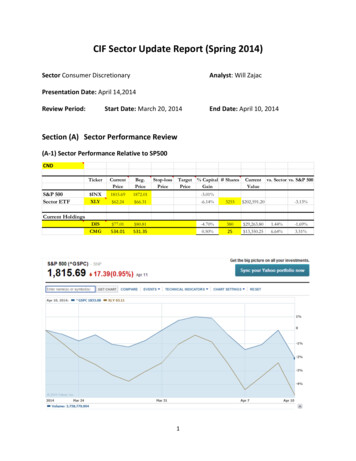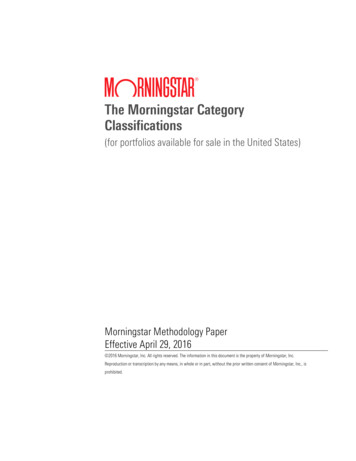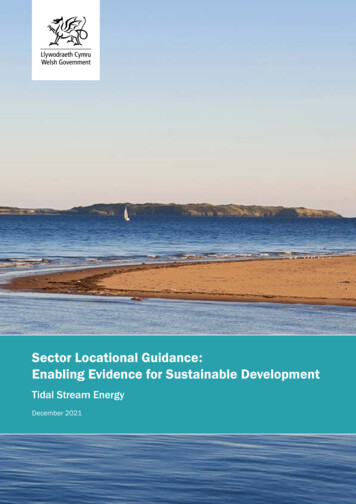
Transcription
1 Sectoral Locational Guidance: Enabling evidence for sustainable developmentSector Locational Guidance:Enabling Evidence for Sustainable DevelopmentTidal Stream EnergyDecember 2021
2 Sectoral Locational Guidance: Enabling evidence for sustainable developmentContext for Sectoral Locational GuidanceThe Welsh Government, as the marine planning authority, has produced this tidal stream energy SectorLocational Guidance (SLG), implementing Welsh National Marine Plan (WNMP) sector supporting policyELC 03b (low carbon energy (supporting) tidal stream), which encourages a collaborative approach tounderstanding opportunities for the sustainable development of the sector.This document represents an ongoing process. It builds on initial work undertaken by Atkins, Venn Associatesand Pembrokeshire Coastal Forum, carried out in collaboration with industry representatives, regulators,and environmental specialists, through a series of stakeholder engagement events.This version of the SLG describes the resources relevant to the sector’s future prospects, how it may interactspatially with other sectors and also wider social and ecological considerations.It is intended this SLG will support the sustainable development of the sector, informing identification offuture opportunities. It will do this by helping guide the industry in their planning for future development(including through signposting to areas of potential consenting complexities), and through promotingengagement and dialogue within and between sectors.Over time, SLG will feed into marine planning, including the potential identification of Strategic ResourceAreas to safeguard areas of tidal stream resource. The Welsh Government is committed to engaging withstakeholders to further develop this SLG.Version 2: Updated June 2022, published June 2022Cover Image supplied by Visit Wales Crown Copyright 2022, Welsh Government, WG45455, Digital ISBN 978-1-80364-418-9Mae’r ddogfen hon ar gael yn Gymraeg hefyd / This document is also available in WelshRydym yn croesawu gohebiaeth a galwadau ffôn yn Gymraeg / We welcome correspondence and telephone calls in Welsh
ContentsCHAPTERSPageContext for Sector Locational Guidance21.8Introduction1.11.21.32.3.4.5.Purpose of Sector Locational GuidanceMarine planning policy contextSector Locational Guidance context and use81012Approach132.12.22.32.413131314Review and integration of existing workStakeholder engagementSectoral interactions assessmentConstraints analysisTidal stream energy resource163.116Resource AreasCurrent activity & future development194.14.24.34.44.51920222324Tidal stream energy technologyProjects in Welsh watersEconomic contributionBusiness supportFuture development l considerations367.Environmental considerations408.Other marine users579.Cross sector interactions & opportunities6910.Regional characterisation7910.110.210.310.410.511.Tidal Stream – West AngleseyTidal Stream – Irish Sea/Llŷn PeninsulaTidal Stream – West PembrokeshireTidal Stream – Bristol ChannelSummary7994108124139References141Appendix A: Data145A.1. Data sourcesA.2. Data limitations/gapsA.3. Data review145152152
4 Sectoral Locational Guidance: Enabling evidence for sustainable developmentTABLESTable 3.1: Tidal stream energy technical parametersTable 4.1: Consents and licences required for tidal stream developmentsTable 9.1: Assessment of interactions, co-existence and co-locationTable 9.2: Tidal stream energy possibilities for co-existenceTable 10.1: Tidal Stream – West Anglesey physical considerationsTable 10.2:Tidal Stream – West Anglesey infrastructure & supply chainTable 10.3: Population and demographics for Tidal Stream – West Anglesey RATable 10.4: Tidal Stream – West Anglesey environmental considerationsTable 10.5: Tidal Stream – West Anglesey other marine usersTable 10.6: Tidal Stream Irish Sea/Llŷn Peninsula – physical considerationsTable 10.7: Tidal Stream – Irish Sea/Llŷn Peninsula infrastructure & supply chainTable 10.8: Population and demographics for Tidal Stream – Irish Sea/Llŷn Peninsula RATable 10.9: Tidal Stream – Irish Sea/Llŷn Peninsula environmental considerationsTable 10.10: Tidal Stream – Irish Sea/Llŷn Peninsula other marine usersTable 10.11: Tidal Stream West Pembrokeshire – physical considerationsTable 10.12: Tidal Stream – West Pembrokeshire infrastructure & supply chainTable 10.13: Population and demographics for Tidal Stream – West Pembrokeshire RATable 10.14: Tidal Stream – West Pembrokeshire environmental considerationsTable 10.15: Tidal Stream – West Pembrokeshire other marine usersTable 10.16: Tidal Stream – Bristol Channel physical considerationsTable 10.17: Tidal Stream – Bristol Channel infrastructure & supply chainTable 10.18: Population and demographics for Tidal Stream – Bristol Channel RATable 10.19: Tidal Stream – Bristol Channel environmental considerationsTable 10.20: Tidal Stream – Bristol Channel other marine usersTable A-1: Data sources used for Tidal stream 5127130133135145FIGURESFigure 1.1:Figure 1.2:Figure 3.1:Figure 3.2:Figure 4.1:Figure 4.2:Figure 4.3:Figure 5.1:Figure 5.2:Figure 5.3:Figure 5.4:Figure 6.1:Figure 6.2:Figure 7.1:WNMP AreaWNMP sector objective and supporting policiesTidal stream potential (flow) with RAs in WalesTidal stream energy RAs around WalesTidal stream devicesExisting tidal energy lease areasOverview of marine licensing process in Welsh WatersCoastal and offshore infrastructure in relation to tidal stream RAsHigh level representation of what the electricity system could look like in 2050North Wales transmission systemSouth Wales transmission systemPopulation size and % of people identifying as Welsh speakingTravel time to key locations (Bangor, Aberystwyth, St. David’s, Swansea and Cardiff)MPAs911171820212930313234383943
5 Sectoral Locational Guidance: Enabling evidence for sustainable developmentFigure 7.2: Environmental designations in relation to tidal stream RAsFigure 7.3: Survey coverage from seabirds at sea dataFigure 7.4: Survey coverage from Marine Recorder data and ground-truthed acoustic datafrom the JNCC combined mapFigure 7.5: Relative potential marine mammal constraints for tidal stream energyFigure 7.6: Relative potential fish constraints for seabed tidal stream energy devicesFigure 7.7: Relative potential fish constraints for mid-water level tidal stream energy devicesFigure 7.8: Relative potential fish constraints for surface water level tidal stream energy devicesFigure 7.9: Relative potential benthic habitat constraints for seabed tidal stream energy devicesFigure 7.10: Relative potential habitat constraints for mid-water level tidal stream energy devicesFigure 7.11: Relative potential habitat constraints for surface tidal stream energy devicesFigure 7.12: Relative potential bird constraints for seabed tidal stream energy devicesFigure 7.13: Relative potential bird constraints for mid-water level tidal stream energy devicesFigure 7.14: Relative potential bird constraints for surface level tidal stream energy devicesFigure 8.1: Marine aggregates and marine disposal areas with tidal stream RAsFigure 8.2:Tidal stream RA and Wave RA overlapping with aquaculture RAsFigure 8.3: Military practice areas with tidal stream RAsFigure 8.4: Energy (including low carbon and O&G) with tidal stream RAsFigure 8.5: Energy (offshore wind site agreements) with tidal stream RAsFigure 8.6: Fishing Intensity in relation to tidal stream RAsFigure 8.7: Fleet landings by Sea Area in relation to tidal stream RAsFigure 8.8: Shipping density, ports, anchorage and restricted sites with tidal stream RAsFigure 8.9:RYA clubs, marinas, training centres and general boating areasFigure 8.10: Subsea cables overlapping with tidal stream RAsFigure 8 11: Protected wrecks and maritime heritage in relation to tidal stream RAsFigure 10.1: High level representation of spatial considerations within the West Anglesey RAFigure 10.2: Tidal flow in the Tidal Stream – West Anglesey RAFigure 10.3: Tidal Stream – West Anglesey environmental designations (Lle, 2020)Figure 10.4: Location of significant issues/constraints in relation to the Tidal Stream –West Anglesey RAFigure 10.5: Location of shipping constraints in relation to the Tidal Stream – West Anglesey RAFigure 10.6: High level representation of spatial considerations within the IrishSea/Llŷn Peninsula RAFigure 10.7: Tidal flow in the Tidal Stream– Irish Sea/Llŷn Peninsula RAFigure 10.8: Tidal Stream – Irish Sea/Llŷn Peninsula environmental designationsFigure 10.9: Location of significant issues/constraints in relation to the Tidal Stream –Irish Sea/Llŷn Peninsula RAFigure 10.10: Location of shipping constraints in relation to the Tidal Stream –Irish Sea/Llŷn Peninsula RAFigure 10.11: High level representation of spatial considerations within the West Pembrokeshire RAFigure 10.12: Tidal flow in the Tidal Stream – West Pembrokeshire RAFigure 10.13: Tidal Stream – West Pembrokeshire environmental 64656667687981859192949699104105108110114
6 Sectoral Locational Guidance: Enabling evidence for sustainable developmentFigure 10.14: Location of significant issues/constraints in relation to the Tidal Stream –West Pembrokeshire RAFigure 10.15: Location of shipping constraints in relation to the Tidal Stream –West Pembrokeshire RAFigure 10.16: High level representation of spatial considerations within the Bristol Channel RAFigure 10.17: Tidal flow in the Tidal Stream – Bristol Channel RAFigure 10.18: Tidal Stream – Bristol Channel environmental designationsFigure 10.19: Location of significant issues/constraints in relation to the Tidal Stream –Bristol Channel RAFigure 10.20: Location of shipping constraints in relation to the Tidal Stream – Bristol Channel RAFigure 10.21: Number of potential constraints to tidal stream energy development120121124126132136137140
7 Sectoral Locational Guidance: Enabling evidence for sustainable developmentACRONYMS AND PWNMPWPDAcoustic Doppler Current ProfilerAutomatic Identification SystemAreas of Outstanding Natural BeautyConsenting Strategic Advisory GroupEnvironmental Impact AssessmentElectricity System OperatorEuropean UnionGigawattHigh VoltageHigh Voltage Alternating CurrentHigh Voltage Direct CurrentInshore Vessel Monitoring SystemLocal AuthorityLower layer Super Output AreaMaritime and Coastguard AgencyMarine Conservation ZoneMarine Energy Engineering Centre of ExcellenceMarine Energy Test AreaMarine Energy WalesMinistry of DefenceMarine Renewable Energy Strategic FrameworkMegawattNatural Resources WalesOffshore Renewables Joint Industry ProgrammeOslo/Paris Convention (for the Protection of the Marine Environment of the North-East Atlantic)Oil and GasOperation and MaintenanceResource AreaRecreational Sea AnglingRoyal Yachting AssociationSpecial Area of ConservationSustainable Expansion of the Applied Coastal and Marine SectorsSector Locational GuidanceSustainable Management of Marine Natural ResourcesSpecial Protection AreaSite of Special Scientific InterestThe Crown EstateUnited KingdomWelsh Index of Multiple DeprivationWelsh Marine Planning PortalWelsh National Marine PlanWestern Power Distribution
8 Sectoral Locational Guidance: Enabling evidence for sustainable development1. IntroductionFor the purpose of this SLG, the following definitionof tidal stream energy should be used:DefinitionTidal stream technologies specifically utilise theflow of water generated by tidal currents. Suitablelocations for the deployment of tidal stream energygenerators are currently limited by the technologyto areas of strong tidal currents (minimum peakspring current of 1.5 m/s).Section 3.1 outlines the different types of tidal streamtechnology currently in development and operation inWelsh waters.1.1 Purpose of Sector Locational GuidanceThe purpose of this document is to supportcharacterisation of areas in Wales where thereis good potential for tidal stream energy projectsto prosper. Bringing together technical andenvironmental knowledge with information on keysocial, cultural and economic issues and using thisto understand future potential opportunities cansupport and enable the sustainable developmentof the sector. This SLG provides a relevant evidencebase for tidal stream energy developers interestedin operating in Welsh waters1, highlighting keyconsiderations and issues that may need to beaddressed during project development and licensingprocesses. It will also inform the ongoing marineplanning process. In order to support potentialcoexistence of multiple uses, the guidance alsoconsiders where opportunities may exist for theco-location of tidal stream technologies with othermarine activities where potentially beneficial andpractical.1The evidence landscape around tidal stream energycontinues to develop, and considerations identifiedin this SLG may change over time. Knowledgegained from the deployment and monitoring oftidal stream energy technologies will also be key tofurther understanding. With time, this guidance maybe developed to provide more specific signpostingtowards areas considered to be of higher potentialfor development.This guidance has been developed in accordancewith the Sustainable Development Principle andthe five ways of working as set out within theWell-being of Future Generations Act. It is alsoinformed by the Sustainable Management of MarineNatural Resources (SMMNR) principles of theEnvironment (Wales) Act, and the direction providedby the United Kingdom (UK) Marine Policy Statementto provide a proactive and spatially planned approachto the management of the marine area.Tidal lagoons (tidal range technologies) are not included in this locational guidance.
9 Sectoral Locational Guidance: Enabling evidence for sustainable developmentFigure 1.1: WNMP AreaSource: WNMP, 2019
10 Sectoral Locational Guidance: Enabling evidence for sustainable development1.2 Marine planning policy contextIn April 2019, Welsh Ministers declared a climateemergency. To address this, the Welsh Governmenthas committed to achieving a carbon neutralpublic sector by 2030 and to make a decisive shiftaway from fossil fuels (Welsh Government, 2019).Welsh Government has committed to reachingnet zero by 2050 and has also set ambitioustargets for the generation of renewable energyincluding for Wales to generate 70% of its electricityconsumption from renewable energy sources by20302. Welsh Government has specific targets forlocal ownership of renewable energy developmentswhich include3:The Welsh Government published the firstWelsh National Marine Plan (WMNP)4 inNovember 2019 to support the sustainabledevelopment of Welsh seas (Figure 1.1). The plan setsout Welsh Government’s vision for the Welsh inshoreand offshore regions and incorporated the WelshGovernment’s aim of supporting the development ofmarine renewable energy in Welsh waters (Figure 1.2). 1 gigawatt (GW) of renewable electricity and heatcapacity in Wales is to be locally owned by 2030;and all new renewable energy projects from 2020onwards are to have at least an element oflocal ownership.2 Oral Statement on “Energy” delivered by the Cabinet Secretary for Environment and Rural Affairs to the National Assembly for Wales on26 September 2017.3 Welsh Government Policy statement: Local ownership of energy generation in Wales – benefitting Wales today and for future generations(Welsh Government, 2020).4 Refer to WNMP: Vision, Objectives and Policies for additional ectives-policies-quick-reference.pdf
11 Sectoral Locational Guidance: Enabling evidence for sustainable developmentFigure 1.2: WNMP sector objective and supporting policiesWNMP Sector Objective: Energy – Low Carbon1. To contribute significantly to the decarbonisation of our economy and to our prosperity by increasing theamount of marine renewable energy generated; and2. To develop Wales as an exemplar of marine renewable energy technology by developing the essential skillbase, infrastructure and technical knowledge to support the development of the industry over the next 20 years.WNMP Sector Specific Supporting Policies ELC 03 a: Proposals for tidal stream energy generation will be supported where they contribute to theobjectives of this plan. Proposals should comply with the relevant general policies and sector safeguardingpolicies of this plan and any other relevant considerations. ELC 03 b: In order to understand future opportunities for tidal stream energy development, relevant publicauthorities and the sector are encouraged, in liaison with other interested parties, to collaborateto understand opportunities for the sustainable use of tidal stream energy resources includingidentification of:– natural resources that provide potential opportunity for future use;– evidence to de-risk consenting for the sector; and– opportunities to define and, once in place, further develop and refine Strategic Resource Areas for tidalstream energy resource safeguarding;i n order to support the sustainable development of the sector through marine planning.Relevant public authorities should make appropriate evidence available to support planning and decisionmaking in order to support the sustainable development of the sector through marine planning, where it isappropriate to do so.Source: WNMP, 2019
12 Sectoral Locational Guidance: Enabling evidence for sustainable development1.3 Sector Locational Guidance contextand useThis SLG brings together information and data froma variety of sources to provide a preliminary evidencebase for those involved in sectoral planning anddeveloping location options for tidal stream energyprojects. The SLG does not rule in or out specificareas for development; instead, it seeks to highlightenvironmental considerations, existing uses andassociated infrastructure, sector interactions andsocial considerations. In doing so, the SLG providesa spatial understanding of potential sustainabledevelopment opportunities and challenges.In considering this SLG, the following points shouldbe noted: Understanding the range and interrelationshipsof a wide range of aspects important to the sectoris a complex process. This guidance necessarilyprovides a high-level assessment of interactionsusing available evidence and incorporatingstakeholder feedback. Maps have been created with accessible dataand show the spatial distribution of activitiesat the time of publication. The absence of datamay appear to indicate areas with few or noconstraints which may be misleading. Such areasshould always be investigated thoroughly as partof any optioneering process. Data used in this SLG is based on informationavailable at the time of publication. As more databecomes available, this will need to be takeninto consideration. The outputs of this SLG do not substitutethe requirement for detailed project levelassessment. This SLG is advisory and has no status inthe decision-making process. It should beread alongside the WNMP and supportingImplementation Guidance5. The presence of an area with a large numberof constraints does not prohibit development.Rather, mapping such information highlights thatan area already hosts multiple activities, containsimportant marine features or is subject to otherconstraints that might make development morechallenging (e.g., take longer, reduce options,or increase costs). As set out in the WNMP,developers are advised to engage regulatorsand stakeholders early in project developmentto identify data needs, scope of assessments,ways of avoiding impacts that would needmitigating and whether mitigation measuresmay be viable. The SLG covers existing activities and looksforward. However, there may be activities that arenot reasonably foreseeable at this time. Evolutionin the use of marine resources and the speed atwhich technology changes will have a bearing onthe options for sustainable use of Welsh mentation-guidance
13 Sectoral Locational Guidance: Enabling evidence for sustainable development2. Approach2.1 Review and integration of existing workThe existing evidence base for future potential tidalstream energy resources has been reviewed and isreflected in this SLG. Sources used for the work areidentified in Appendix A. Key sources include: SMMNR project reports (ABPmer, 2021forthcoming). Elements of the SMMNR data havebeen incorporated into this SLG (see Sections 7and 10 for further details)6. Marine Renewable Energy Strategic Framework(MRESF) (Welsh Government, RPS 2007-2010). A review of the potential for co-existence ofcertain sectors in the WNMP Area (Cefas, 2020).2.2 Stakeholder engagementEffective and collaborative stakeholder engagement,creating cross-sector dialogue reflecting activitiesand interests across Wales, has been fundamentalto the development of this SLG. This includes thoseoperating within the tidal stream energy sector butalso connects with representatives of wider marineinterests in Wales and other maritime activities.2.3 Sectoral interactions assessmentSectoral Interactions Matrices have been usedelsewhere in the UK as a means of capturingstakeholders’ views on the nature of interactionsbetween marine-related activities and interestsin the early stages of marine planning for specificareas. This has been adapted for the SLG processto demonstrate the perceptions of interactionsbetween the focal sector (tidal stream energy) andother marine sectors in Wales and provides a high-levelassessment and a starting point for more detailed andin-depth studies in particular Resource Areas (RAs).6Sector interactions are used to inform theconstraints analysis, and to better understandpotential opportunities in the context of WNMPpolicy ECON 02 (coexistence) coupled with WNMPsector supporting policies.Sectoral interactions assessment differs from theconstraints analysis. Constraints analysis considersinteractions in a way that may actively enable orpreclude different activities from taking place as partof a decision-making process. Sectoral interactionsassessment takes a more fundamental view ofwhether activities are perceived as being compatiblewith each other and helps contextualise spatialconstraints analysis.The following definitions are used for the sectoralinteraction assessments: Interactions: where the proximity of two or moreactivities causes them to have an effect oneach other. Interactions can be positive, neutral,or negative. They can also be likely, possibleor unlikely. The assessment of interactionsinvolves an element of judgement: two, or more,assessments of the same interaction may notreach the same conclusion about its outcome. Co-existence: Where multiple developments,activities or uses can exist alongside or closeto each other in the same place and/or at thesame time. Co-location: A subset of coexistence wheremultiple developments (often structures),activities or uses are located in the same placeby sharing the same footprint or area in themarine environment. ‘Footprint’ can include boththe physical location of a development or activitye.g., a built structure, and a wider area associatedwith the development or activity e.g., a surroundingsafety zone. It could involve designing projects toaccommodate multiple uses of marine space.Sustainable management of marine natural resources sources
14 Sectoral Locational Guidance: Enabling evidence for sustainable developmentThe approach to sectoral interactions used in theCefas review of the potential for co-existence ofdifferent sectors in the WNMP area7 has beenadapted for this SLG. A range of marine activitieshave been assessed against the tidal stream energysector and it has been identified where interactionsand the potential for co-existence and/or co-locationmight be likely, possible or unlikely (See Section 9 forfurther details).2.4 Constraints analysisConstraints mapping has been undertaken tosupport the implementation of WNMP generalpolicies (protecting socio-economic or environmentalconsiderations) as well as safeguarding other sectors’interests (policies SAF 01a and b).Sector-sector interactions have been consideredto inform the constraints analyses and to betterunderstand potential opportunities as a contributionto policy ECON 02 (coexistence) coupled with therelevant sector supporting policies.Constraints analysis mapping is a process of mappingand interpreting spatial evidence to understand,for a particular activity or development, the spatialconsiderations which may influence the prospectsof a proposal in a particular area. As a first stepto understanding these spatial considerations,a list of key potential constraints to tidal streamenergy development was identified drawing uponprevious work undertaken for MRESF, alongsideexpert judgement. The distribution of these potentialconstraints was mapped to a 1 km2 hexagonal grid,the same as that used for the SMMNR project, andthe number of potential constraints was summed andis shown in Figure 10.21. The legend to Figure 10.21lists the mapped potential spatial constraints.Taken further, constraints analysis could develop amore refined understanding of spatial considerationsto show differences in the relative constraints acrossareas. There is the potential to weight the relativeimportance of constraints in relation to the sector,and to combine multiple constraint layers to betterunderstand their implications for development ofthe sector. Constraints mapping can be a useful toolto inform sectoral strategic planning but any suchmapping exercise should clearly present the levelof confidence and caution that should be appliedin interpreting the resultant maps.Developers will have different approaches, priorities,and risk appetites in relation to projects and willtypically undertake their own constraints analysisin the project development process. The analysispresented here is intended to provide an accessibleand focussed evidence base, and an early/high levelindication of potential risks/issues to consider inthe site selection process. It could also contributeto supporting the implementation of the WMNP’sgeneral policies, such as protecting socio-economicor environmental considerations (ECON 01),considering co-existence opportunities (ECON 02),and safeguarding other sector interests(SAF 01a and b).Analysis of potential constraints to developmenthas drawn on existing data, which has beensupplemented with information gathered throughstakeholder engagement and in discussion withNatural Resources Wales (NRW). The assessmentof constraints relating to the different forms of tidalstream energy considered in this SLG is based oninformation gathered during the MRESF project andhighlights those aspects where interactions betweenthe itemised elements may be considered as asignificant constraint. Elements given a high score(a score of 4 or 5) would likely cause delay and couldpossibly stop a tidal stream energy project fromprogressing.7 Cefas, 2020. Mengo, E., Mynott, F. and Muench, A. A review of the potential for co-existence of different sectors in the Welsh Marine Plan rent-sectors-welsh-marine-plan-area
15 Sectoral Locational Guidance: Enabling evidence for sustainable developmentAt the site selection stage, environmentaldesignations are typically used by developers as anindication of the potential sensitivity and consentingrisk associated with an area. Although site boundariesprovide a limited indication of features and locationsof mobile species, additional important considerationsmay lie beyond the boundaries but still need to betaken into account.Environmental sensitivities are more nuanced thansome of the physical characteristics or constraintsassociated with other marine users. The scoringapproach used in SMMNR has attempted to reflectthe spatial occurrence, conservation importance,and potential for impact pathways for differentfeatures. SMMNR outputs have been includedin the constraints analysis. Further detail on theassessment of environmental sensitivities and theinterpretation of the scoring outputs can be foundin the SMMNR reports8.8For the majority of constraints, both from othermarine users, activities and ecological sensitivities,there are opportunities to either manage theinteraction, microsite around key sensitivities,or apply appropriate mitigation. These options canonly be properly explored at project level, so suchareas should not be excluded prematurely at the siteselection or marine planning stage but recognisedas areas with particular characteristics which requireconsideration. Nevertheless, it is also recognisedthat there are some consenting risks that requirebetter understanding before they can be resolved.If the risks are considered significant enough it maybe appropriate, sensible, and more cost-effective toexclude the site at an early stage of any site selectionprocess.Sustainable management of marine natural resources sources
16 Sectoral Locational Guidance: Enabling evidence for sustainable development3. Tidal stream energy resource3.1 Resource AreasThe tidal stream RAs9 are defined in the WMNP(Figure 3.2), as informed by a study commissionedby Welsh Government in 2011 (MRSEF, 2011).There are four tidal stream RAs; these are consideredseparately within this SLG in Sections 10.1 – 10.4.Tidal stream resource is the key driver for siteselection. The available tidal stream energy is basedon are
Figure 3.2: Tidal stream energy RAs around Wales 18 Figure 4.1: Tidal stream devices 20 Figure 4.2: Existing tidal energy lease areas 21 Figure 4.3: Overview of marine licensing process in Welsh Waters 29 Figure 5.1: Coastal and offshore infrastructure in relation to tidal stream RAs 30 Figure 5.2: High level representation of what the .
